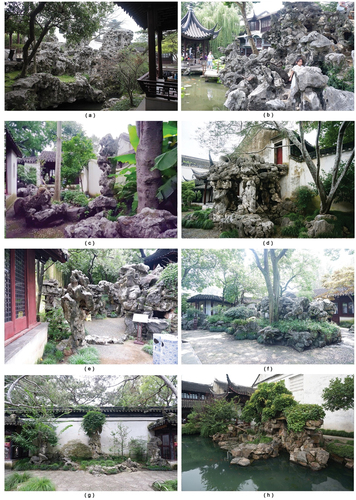ABSTRACT
Based on the rockery photos of 10 classical gardens including world cultural heritage, this paper incorporates the combined analysis and comparison of constituent elements (rockeries, buildings and plants) of scenic surfaces, and probes into the fractal characteristics of landscaping through the theory and the fractal dimension (FD) value analysis software. Studies have shown that the quantitative evaluation data of visual complexity (FD, i.e., fractal dimension) can characterize the contour morphology of constituent elements of the scenic surface of rockeries. The relevant analysis results are as follows: (1) FD can directly quantify the morphological contour of each element. Through the statistical analysis, it can effectively avoid the misjudgment of empirical cognition and subjective feeling. Therefore, FD value can be used as one of the effective indexes to evaluate the complexity and diversity of rockery and landscape elements. (2) The change in the level of the FD value enables the intuitive analysis of the effects of the plant varieties and landscaping techniques on rockery morphological complexity. (3) Higher FD value is not always better. Necessary morphological maintenance is required to avoid excessive FD value of plants.
1. Introduction
Chinese classical gardens showcase a high level of artistic achievement in their unique style and have turned into the most important part of the world’s garden history, having been reputed as “the Mother of Gardens” (Meyer Citation2010; Wilson Citation2004; Liu Citation2005). Since the Tang Dynasty, Chinese gardens have brought about a great impact on gardens in many parts of the world. They are also a microcosm of Chinese culture. The enduring passion and cultural worship for natural landscape and stones are reflected in the rockery build-up in the art of gardening (Xu Citation2014). Rockeries, as an important element of Chinese classical garden design, exhibit strong representativeness and symbolic significance (Aplin Citation2007; Zheng Citation2013). For instance, Bai Juyi, a famous ancient Chinese poet who loved stones, believed that “famous gardens are perfect with stacked stones” (Bai Citation1915). Some later gardening theorists and craftsmen also believed that “rockeries and pools” are extremely important for garden landscaping (Stuart Citation1990), and that “rockeries are more important” (Fang Citation1994). Therefore, the position of rockeries in gardens and courtyards is similar to the sculptures or memorial columns in Western-style gardens and squares. Additionally, they constitute space framework and central focus (Graham Citation2005; McDermott Citation1990). It is also a result of artistic creation based on and beyond nature, using engineering techniques and skills to pursue poetic and picturesque environments (Gu Citation2021). Such rockeries built from natural irregular stones have been regarded as a unique cultural heritage in the world thanks to their unique characteristics (Fang Citation1994; Han Citation2010; Sun Citation2007), and they are hard to copy; therefore, it is extremely essential to study and protect them.
1.1. Historical and morphological studies on rockeries
The descriptions of rockery contour morphology have been recorded in ancient books and documents since the Song Dynasty. In addition to the commonly known features such as “thinness, wrinkles, cutout, and perspective” (Stuart Citation1990; Gu et al. Citation2015; Zheng Citation1979), the ancients believed that the shapes and contour lines of mountain stones were the important criteria for the appreciation and selection of stones in classical gardens (Bai Citation1915; Stuart Citation1990; McDermott Citation1990; Li Citation2000; Giovanni Citation2010). There have been studies on the evaluation and analysis of mountain stone contours and rockery pattern, mostly describing personal subjective experience (Jin Citation2005; Chen Citation1982); however, there are only a few objective evaluation and analysis-based studies (Liang, Li, and Zhang Citation2019). The way of documentation principally relies on the drawings (abstract expressions) created with brush pens and digital image recording (Gu et al. Citation2015; Hiscox Citation1978; Zhu Citation1851; WuZhong and Xiaoyan Citation2010). This important measure for the sense of the form of rockery is difficult to pass on due to the lack of research attention and objective quantitative criteria. This not only brings about the lack of modern people’s ability in rockery appreciation and stone selection criteria but also leads to the inadequate consideration of contour morphology in modern rockery creation engineering (Sun Citation2007, Citation2004). Therefore, it is essential to choose the appropriate quantitative analysis methods to identify the quantitative of rockery contour morphology appreciation and stone selection criteria, to provide a necessary reference for rockery studies, repairs and maintenance, and to provide certain guidelines for the morphological design of modern rockery engineering.
1.2. Analytical study on fractal quantification
Fractal dimension (FD) is mathematically described as a dimension with non-integer values; it is an indicator of visual complexity. The method of measuring FD was first proposed by Benoit Mandelbrot in 1977 (Mandelbrot Citation1977), and then the origin and new application of this concept were clearly summarized; later, it was further applied to the complexity description of natural shapes (Mandelbrot Citation1983); then, Richard Voss focused on Mandelbrot’s fractional Brownian motion in his study (Voss Citation1986). It is used to describe irregular or even fragmented shapes, such as curved coastlines, undulating mountains and changing clouds, which are “self-similar” at various scales (Mandelbrot Citation1967). With FD as a quantitative parameter, the fractal theory addresses and reveals the regularity and hierarchy hidden in morphological contours (Zhang Citation2011; Stamps Citation2002). Since the 1990s, this method has been discussed and applied in urban planning and architecture (Michael and A Citation1994; Bovill Citation1996). Some researchers even analyzed and studied the contour morphology of study objects by using the fractal dimension method, and performed further studies in combination with landscape preference (Hagerhall, Purcell, and Taylor Citation2004), landscape quality perception (Jon, Su, and Reza Citation2013), and visual complexity (Gunawardena, Kubota, and Fukahori Citation2015; Ata, Philip, and Yazid Citation2019; Lionar and Ediz Citation2020). Most of the research objects were large-scale architectural communities or urban scenes, which were different from studies on small-scale rockery in Chinese Garden. However, fractal studies associated with Chinese classical gardens were still lacking, especially studies on the fractal dimension of rockery scenic surfaces in classical gardens south of the Yangtze River (Ding et al. Citation2021). In this respect, FD brings the possibility of quantitative analysis of rockery contour morphology.
1.3. Relationship between rockery and fractal
The principle of fractal geometry focuses on the description of complex and disordered profiles of nature, which coincides with the philosophy of “inspired by nature” (Yan et al. Citation2017b; Briggs Citation2005). The beauty of disorder, roughness, irregularity, and complexity that is described by the fractal beauty to disrupt the harmonious whole meets the criteria of “thinness, wrinkles, cutout and perspective” for stone appreciation and selection, and is in keeping with the natural irregularity of space and the asymmetrical form of the rockeries in classical Chinese gardens (Spehar et al. Citation2003; Nayak, Mishra, and Palai Citation2019). The classical Chinese garden’s “varying landscape for each step” viewing style and the landscaping feature of landscape painting’s scattered perspective also demonstrate the idea of fractals and the beauty described by them (Wang and Shen Citation2020; Bian Citation2019a; Feng, Tian, and Tian Citation2016; Ma, He, and Lu Citation2021). The technique of stone laying can be likened to the fractal composition method under the action of linear transformation group (Mao and Lei Citation2005). Rockeries and their combined elements conform to the “irregular shape” principle of fractal geometry theory. Fractal geometry is consistent with the irregularity of the composite forms of Chinese gardens (Tian, Yan, and Wei Citation2015). At present, the fractal studies in this field are principally on the rendering of garden natural landscape (Wang Citation2012), architecture and garden design (Feng, Tian, and Tian Citation2016; Li and Liao Citation1998), and spatial form analysis (Mao and Lei Citation2005), having probed into the internal relationship between Chinese classical garden and fractals from a broader chaotic perspective (Shao and Hao Citation2005).
In this field, this method has not yet been used in the studies on the forms of facade profile of rockeries. Therefore, the present study attempts to build on the previous ones by increasing the sample size and further using FD to quantitatively analyze and study the traditional rockery contour morphology in classical gardens south of the Yangtze River (Ding et al. Citation2021). The study is to explore the elements and reasons affecting the visual complexity of scenic surfaces of traditional rockeries and the effect of each constituent element on FD, so as to provide a more rational and objective quantitative evaluation method for the diversity and complexity of the contour morphology of traditional Chinese rockeries.
2. Research AIM
In the present study, the rockeries of the 10 famous classical Chinese gardens, including those listed by UNESCO, are selected as samples, and the fractal box dimension is used to investigate and perform morphological quantitative analysis for the rockeries in classical Chinese gardens, in an attempt to reveal the landscaping characteristics and visual complexity of the rockeries in classical gardens south of the Yangtze River. The study will fulfil the following objectives: (1) To quantify the FD of the optimal scenic surface contour morphology by fractal box dimension; (2) To statistically analyze the fractal characteristics of the fractal box dimension of rockeries and their landscaping elements in 10 classical gardens; (3) To study the landscaping characteristics of scenic surfaces in classical gardens south of the Yangtze River by statistically analyzing the FD value between individual landscaping elements (rockeries, buildings, and plants) and their combinations.
3. Method
3.1. Investigation site and materials
Nine World Cultural Heritage sites (), including the Humble Administrator’s Garden (ZZY), the Lingering Garden (LY), the Net Master’s Garden (WSY), the Mountain Villa with Embracing Beauty (HXSZ), the Canglang Pavilion (CLT), the Lion Grove Garden (SZL), the Couple’s Garden Retreat (OY), the Garden of Cultivation (YP), the Retreat and Reflection Garden (TSY) and the Yi Garden (YY) were selected as sampling sites (http://whc.unesco.org/en/list/813/). All of these Chinese traditional gardens date from BC.514 to AD.1882. Stone arrangement works were selected from these 10 Chinese traditional gardens.
Figure 1. Investigation Site: (a) Location of Suzhou City, Jiangsu Province, China; (b) Location of the ten gardens within the site of garden mapping in Suzhou; (c) The Retreat and Reflection Garden; (d) The Lingering Garden; (e) The Couple’s Garden Retreat; (f) The Canglang Pavilion; (g) The Net Master’s Garden; (h) The Garden of Cultivation; (i) The Yi Garden; (j) The Mountain Villa with Embracing Beauty; (k) The Humble Administrator’s Garden; (l) The Lion Grove Garden.
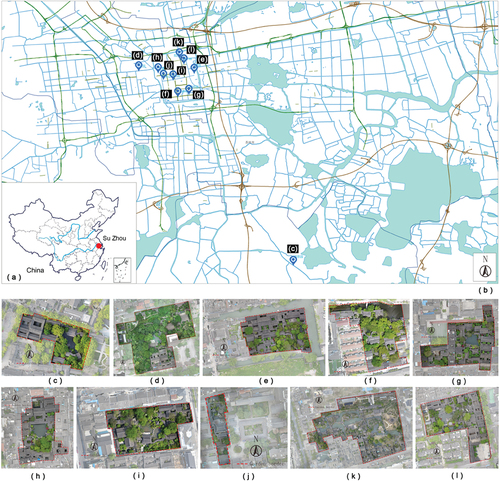
Notable rockeries in the WSY include the Peony Study, the lake-stone rockery in front of the Hill Cong Guixuan, and the yellow-stone rockery Yugang next to the Zhuoyingshuige ()) (Guo, Li, and Tuo Citation2021). The Astor Court, a Chinese courtyard in the Metropolitan Museum of Art, completed in 1979, is a copy of the Peony Study (). In addition, the Gumu Jiaoke (Xiao Citation2016), the Hanbi Mountain Villa (Ke Citation2019), and the Huabu xiaozhu in the LY illustrated in are all famous attractions in the garden. The Malus Spectabilis Garden Court in the ZZY is typical of the rocks arranged in front of a white wall as a group ()), in which several begonias and a cluster of bamboo are planted along the white wall (Zhang Citation2015), as shown in . The Nine-Lion Pavilion in the Lion Grove Garden is one of the many representatives of the famous lake-stone pinnacles ) (Tian and Fang Citation2017). The rockeries in the HXSZ shown in ) are said to have been built by Ge Yuliang, a master of rockery creation in the Qing Dynasty, inheriting the “charm of stroke” of Shi Tao, a famous landscape painter of the Qing Dynasty (Liu Citation2005; Jun Citation1984; Liang et al. Citation2018). Since the YY was built late, it took on the strengths of the other gardens; for instance, the double verandas connecting the houses were modeled on the CLT; the ponds in the garden were modeled on the WSY; the rockeries and caves were modeled on the SZL (Gu et al. Citation2018). The gardens are established in cities, mimicking the natural landscape settings (Bian Citation2019b); moreover, they are complex and irregularly shaped, in keeping with fractal geometric features.
Figure 2. Rockery in Suzhou Classical Gardens: (a) The Huangshi Rockery Yugang (“云岗”); (b) The Gumu Jiaoke (“古木交柯”); (c) The Huabu Xiaozhu (“花步小筑”); (d) Taihu Lake stone group near the Hanbi Mountain Villa (“涵碧山房”); (e) The Malus Spectabilis Garden Court (“海棠春坞”); (f) The Xiangshui Chunnong (“香睡春浓”); (g) The Nine-Lion Pavilion (“九狮峰”); (h) The TaiHu Stone Rockery in the HXSZ.
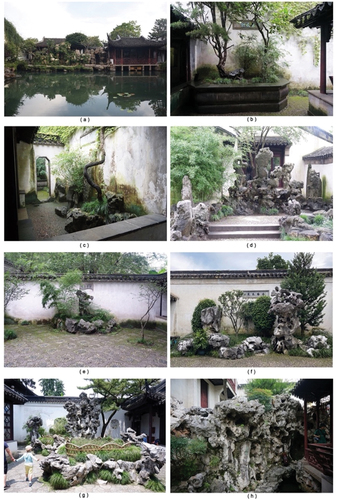
Figure 3. The Astor Court(a)-1, (a)-2 versus the Peony Study(b)-1,(b)-2. (a)-1, The picture is from the website of the Master-of-Nets Garden; (b)-1, The picture is from the website of China.org.cn; (b)-2, The picture is from the website of the Metropolitan Museum of Art.
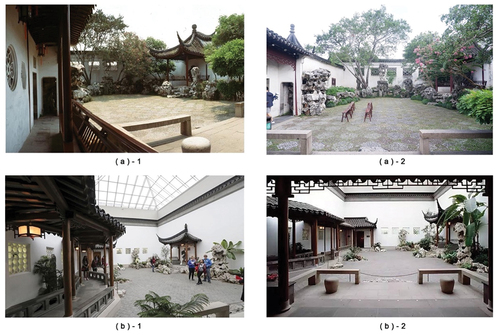
Figure 4. Schematic diagram of the sample photographing for scenic surfaces: (a) General layout of gardens for the Mountain Villa with Embracing Beauty; (b) Photography method for large-volume sightseeing rockeries; (c) Photography method for rocks arranged in front of a white wall as a group; (d) Photography method for ad hoc rockeries.
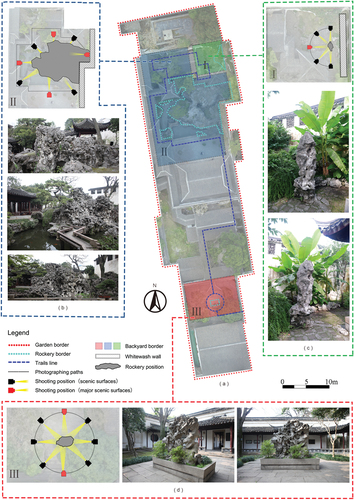
3.2. Methods for analyzing FD value
Chinese classical gardens pursue the viewing feature of “varying landscape for each step” (Bian Citation2019a). Therefore, rockery stacking masters exhibit the major scenic surface scenery of rockery along tourists’ walking paths, in addition to setting up viewpoints along such paths. Hence, the paths around rockeries turn into fixed tour routes for viewing rockeries. The present study employed digital imaging technology to sample the scenic surfaces of the rockeries in 10 gardens, based on the viewing style of “varying landscape for each step” and the typical characteristics of rockeries in classical gardens. A total of 214 photograph images of the scenic surfaces of rockeries in 10 gardens were taken, and each image was divided into seven sample types of feature information to be used as the base data for FD analysis.
3.2.1. Method of taking rockery images
(1) Shooting position: Firstly, all viewpoints were chosen according to the fixed route for viewing rockery, based on tourists’ viewing habits to avoid viewing subjectivity. Secondly, for the objectivity of the experimental data, the sampling direction of the photos of the rockery major scenic surface was fixed, that is, the east, south, west, and north positive upward viewing facade were used in most cases. This not only avoided the subjectivity of deliberate framing angle, but also gave a more comprehensive reflection of the outer contour characteristics of the rockery, as shown in . In addition, the GPS-RTK (version iRTK2 Classic Edition, Hi-Target, Inc., Guangzhou, China) (±1 cm) sampling points of each sampling rockery were recorded for the objectivity and reproducibility of photo sampling ().
Figure 5. The rockery photo sampling location coordinates recorded with the RTK: (a) Image of the Yi Garden with recorded the RTK sampling points; (b), (c), (d) Sampling work photo for the investigation site.
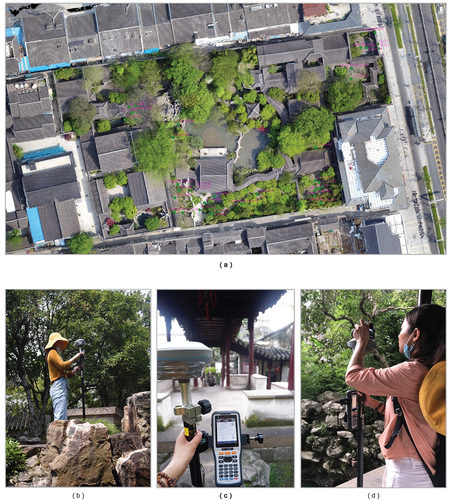
(2) Shooting height: In reference to the average heights of men and women in citizens profile reports of China and Jiangsu Province, the average line-of-sight height for the present photo sampling is set to around 1.55 m [96].
(3) Shooting distance: Photographing and sampling are performed with consideration to the type and height of rockery depending on the optimal visual distance for rockeries.
(4) Camera settings: To achieve a viewing effect close to the human field of view, the photo sampling camera is set to a wide-angle shooting with a focal length f = 35 mm. The photo framing size is 5165 × 3744 pixels.
Our experiment was performed from 16 July 2020 to 29 July 2020 in sunny or cloudy that for 14 days. Digital camera (FUJIFILM, XT100, Fuji, Japan) was used to take photos of sampling stones. Each photo was taken from different sites (Scenic surfaces, ). Take at least three photos at each site (). Totally, 214 photos were collected as samplings of this study, including the ZZY (18 images), the LY (25 images), the WSY (16 images), the HXSZ (21 images), the CLT (14 images), the SZL (21 images), the OY (31 images), the YP (17 images), the TSY (32 images) and the YY (19 images).
3.2.2. Fractal image processing and analysis
Contour line of each sampling stone was delineated by Adobe PhotoShop CC 2018 software (version 19.0, Adobe Systems Inc., San Jose, CA, USA) and saved as TIFF file (). Fractalyse software (version 2.4.1, ThéMA, UBFC, CNRS, Besançon, France) was used fractal box dimension to calculate FD value of each TIFF file of sampling stone (Hagerhall, Purcell, and Taylor Citation2004; Ediz and Ostwald Citation2012). Seven types of FD values of TIFF file of the same sampling photo were calculated:
Figure 6. Schematic diagram of fractal box dimension analysis for rockeries: (a) Rockery sampling photo of the HXSZ; (b)-1, (b)-2, (b)-3, (b)-4, (b)-5, (b)-6, (b)-7 FD value analysis diagram.
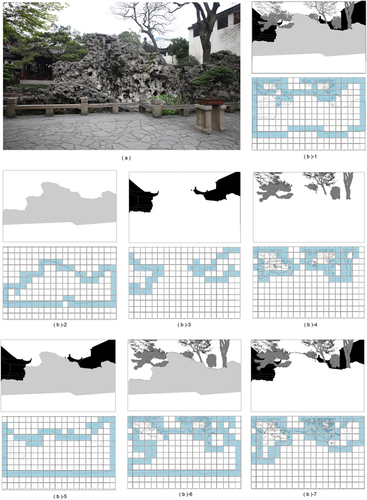
(1) FD value with contour line of rockeries only in each TIFF file (JS), )-2.
(2) FD value with contour line of buildings only in each TIFF file (JZ), )-3.
(3) FD value with contour line of plants only in each TIFF file (ZW), )-4.
(4) FD value with contour line of both rockery and building in each TIFF file (JS_JZ), )-5.
(5) FD value with contour line of both rockery and plant in each TIFF file (JS_ZW), )-6.
(6) FD value with contour line of both plant and building in each TIFF file (JZ_ZW), )-7.
(7) FD value with contour line of rockeries, plants, and buildings in each TIFF file (ZH), )-1.
3.3. Methods of statistic and analysis
Pearson correlation analysis was used to find whether there is relationship between all elements with ZH’s FD value (). Then, according to the result, make a further research between ZH’s FD value and the element which shows a significant relationship with it (ZW, JS_ZW and JZ_ZW) by Simple linear regression model (). Multivariable linear regression model was used to contribution degree among the FD values of JS, JZ and ZW with ZH’s FD value (). SPSS software (version 20.0, SPSS, Inc., Chicago, IL, USA) was used for Pearson correlation analysis and Multivariable linear regression model ().
Figure 9. Regression analysis of the FD of ZW, JS_ZW, JZ_ZW with ZH: (a)-1,(a)-2, (a)-3, The LY; (b)-1,(b)-2, (b)-3, The ZZY.
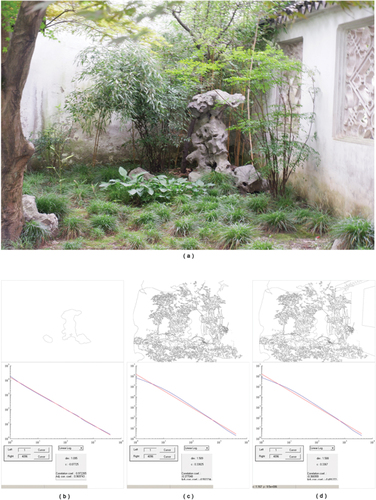
Table 1. The statistics parameters of fractal dimension for various elements of rockery views.
Table 3. The contribution analysis of JS, JZ, ZW to ZH’s FD.
4. Result
4.1. FD values of seven types of photos
According to the analysis results of the survey, the FD is between 1.297 and 0.69 for JS, 1.769 and 1.013 for ZW, 1.550 and 0.9534 for JZ, 1.766 and 1.055 for ZH (except 13 samples without architectural elements), 1.540 and 0.69 for JS_JZ, 1.769 and 1.055 for JS_ZW, and 1.766 and 1.073 for JZ_ZW. It can be seen from that the fractal dimensions of elements for scenic surface of rockery, from high to low, are as follows: ZH (1.446 ± 0.009) > JZ_ZW (1.444 ± 0.009) > ZW (1.434 ± 0.010) > JS_ZW (1.434 ± 0.009) > JS_JZ (1.206 ± 0.006) > JZ (1.164 ± 0.008) > JS (1.126 ± 0.005). There is no significant difference in fractal dimension among ZH, JZ_ZW, ZW and JS_ZW. However, the differences from said four groups from JS_JZ, JZ and JS are significant (p < 0.05). Among the three individual elements (JS, JZ and ZW), ZW has the highest FD. The FD difference between JS and JZ is not significant, but both are significantly different from ZW (p < 0.05).
This is because the plants in Chinese classical gardens are principally sight-seeing ones, and the leaves and branches of the plants themselves have self-similar fractal contours. Hence, the combination of ZW and JS or JZ can greatly improve the fractal dimensions of both, while the fractal dimension of plants is also significantly higher than that of JS, JZ, and JS_JZ (, p < 0.05). This demonstrates that plants can significantly enhance the complexity of rockery scenic surface and building contour morphology, thus playing a positive role in enhancing the richness of rockery scenic surface. Previous studies have also shown that classical gardens in Suzhou stress plant collocation and frequently adopt the natural alternation-based landscape organization techniques, having attached importance to the hierarchy and collocation among buildings, stones, waters, etc. The arrangement of flowers and trees can form a small courtyard landscape, while its morphology and location play a great role in the composition of architectural landscape; they can form nice garden landscape pictures.
4.2. Correlation of FD value and elements of rockery scenic surfaces
Pearson correlation analysis on FD of rockery landscape composition elements in 10 gardens shows that each element of rockery scenic surfaces (), including, plant (ZW), building (JZ), rockery (JS) and their combinations of either two of them (JS_JZ, JS_ZW, JZ_ZW), have the following characteristics on the FD correlation of the total combination (ZH): ZW and the combinations containing ZW (JS_ZW, JZ_ZW) are significantly correlated with the variation of FD in ZH (p < 0.05). While JS, JZ and JS_JZ are not significantly correlated with the variation of FD in ZH (p > 0.05).
Table 2. Pearson correlations of regression analysis of FD value for elements of rockery scenic surfaces with ZH.
Among the individual elements, ZW affects FD in ZH significantly in all 10 gardens (p < 0.05). The results of FD analysis of individual elements JZ and ZH show that the JZ of the HXSZ, the SZL and the YP were significantly correlated with FD in ZH (p < 0.05), while JZ of other seven gardens are not significantly correlated with FD in ZH (p > 0.05). However, the individual elements JS shows significant correlation only in the OY on FD value in ZH (0.408, p < 0.05), but there is no significant correlation for other gardens (p > 0.05).
After pairwise combinations of individual elements, a comparative analysis with ZH reveals that FD value in JS_JZ is only significantly correlated with ZH in the HXSZ and OY (p < 0.05), with the correlation coefficients of 0.467 and 0.421, respectively. In 10 gardens, JS_ZW and JZ_ZW all show significant correlation with FD in ZH (p < 0.05), in which JS_ZW of other gardens shows a very significant positive correlation with ZH except for the HXSZ and the SZL (p < 0.01), with the correlation coefficient greater than 0.9. In terms of the correlation between JZ_ZW and ZH, all the other seven gardens, except for the three gardens, the HXSZ, the SZL and the TSY, show a very significant positive correlation (p < 0.01), with a correlation coefficient greater than 0.9.
Studies have shown that rockeries are an extremely important part and central focus of garden landscaping (Liu Citation2005; Stuart Citation1990; Graham Citation2005; McDermott Citation1990). Some later gardening theorists also believed that “rockeries are main object” (Fang Citation1994). However, shows that except the OY, no significant relationship between JS and ZH’s FD value (p > 0.05). This suggests that scientific and objective fractal quantification methods help effectively avoid empirical perceptions and subjective sensation-induced misjudgment. FD value can serve as one of the effective indicators to assess the scenic surface complexity and diversity of rockeries and landscape elements.
Moreover, in the stone arrangement landscaping with walls as a backdrop, it is hard to present the overall contour morphology of buildings in scenic surfaces. However, it is common for designers to make use of the variously shaped latticed windows to enhance the richness and complexity of white walls (). It is thus clear that buildings can also increase the FD of rockery scenic surfaces in some gardens (HXSZ, SZL, YP; ).
4.3. Regression of FD values and elements of rockery scenic surfaces
The simple linear regression analysis of these sample data with significant positive correlation shows that their influence trend on the FD value of ZH is basically the same.
ZW, JS_ZW and JZ_ZW of 10 gardens have a very significant positive correlation with the FD value of ZH (p < 0.01). Take the LY and the ZZY as examples (), with the FD value of ZW increases, the FD value of ZH rises significantly (LY: R2 = 0.76; ZZY: R2 = 0.91, p < 0.01), ZH’s FD value will also increase significantly with the increase of the elements which contains plants, like JZ_ZW and JS_ZW. From this point of view, plants can remarkably improve the contour morphology complexity of rockeries and buildings scenic surfaces, which may have a positive effect on enhancing the richness of rockery scenic surfaces.
4.4. Contribution of FD values and elements of rockery scenic surfaces
By multivariable linear regression model analysis, it is found that the contributions of ZW’s FD value to ZH are higher than JZ and JS’FD values (). Among the 10 gardens’ rockery scenic surfaces, ZW’s FD value contributes the most to ZH, and they all show a significant contribution except SZL (p < 0.01). Only in HXSZ and SZL the FD values of ZW show a slightly lower contribution to ZH, respectively, are 0.450 and 0.399, but in other gardens, the values of contribution all exceed 0.8. In comparison, the FD values of JS and JZ show lower contribution to ZH, only are significant in YY (0.126). Among the influence of JZ’s FD values to ZH, the significance is shown only in HXSZ and YY (0.789, 0.126), while other gardens do not show.
Studies have also shown that classical gardens in Suzhou place stress on the hierarchy and matching of plants, buildings, stones, waters, etc., with each other to enhance the appeal and that the morphology and location of plants also play an important role in the composition of buildings and garden scenes (Liu Citation2005) ().
5. Disscussion
5.1. Enlightenment of FD values on making Chinese classical garden rockery
Based on the statistical analysis of rockery landscape element’s FD values, it is found that can be used as one of the quantitative methods for the evaluation of ornamental characteristics of rockeries. Because the results of statistical analysis are related to the type of rockery and its landscaping characteristics. Therefore, through the statistical results of the FD value, the optimization of the rockery landscaping contour morphology can be realized. For example, although ZW has the highest contribution to the FD value of ZH, but in the HXSZ and the SZL, the contribution is lower. Moreover, the FD value of JZ contributes the highest to ZH. This may be because the rockeries of the HXSZ and the SZL are sightseeing rockeries and are relatively large in volume ()), and the buildings of the HXSZ are arranged around the rockeries (). The contribution of JS’s FD value to ZH is higher than JZ’s in the OY, and is the same in the YY, the WSY, and the YP (). This may be because the contours of the rockery in the YY, the WSY and the YP gardens are relatively rich, and most of them are the “rocks arranged in front of a white wall as a group” type ()), so the contours of architectures have relatively little influence on the complexity of the rockery scenic surfaces (). The rockeries in the OY are mostly located in the center of the courtyard of the building, belonging to the “ad hoc rockeries” type (), )). Therefore, the outline shape of the building will be more displayed in the analysis photos. This makes the values of JS and JS_JZ have a significant correlation with ZH’s FD value in the OY (, p < 0.05).
According to the survey, there is a clear diversity of morphology between the stone arrangement of rockeries and their combinations in these gardens; hence, it can also be inferred that the rockery contours in each of the gardens are clearly diverse due to the different forms of layout, the varying characteristics of the stones, the different location and areas in which the gardens were built. Furthermore, the landscaping of each rockery is individualized design creation performed through certain landscaping elements. As masters of rockery creation have argued, “a garden rockery should be a well-designed integration with buildings, plants, and the surroundings” (Han Citation2010; Sun Citation2007). The outcome of such creation, characterized by diversity and unity in form, conforms to certain laws of beauty in form. It demonstrates that the application of the laws of formal beauty, such as “diversity and unity”, can be verified in the creation of rockery stone arrangement by using quantitative data on rockery contour morphology. This is also informative for the future deeply study of garden aesthetics and the assessment of visual quality. This implies that the quantitative analysis results of FD can provide a referential method for contour morphology design and evaluation of rockeries shape, and is particularly useful for the morphology design of modern rockery piling engineering and cement forming of rockery.
5.2. Limitations and prospects of FD values
According to the analysis, the value of FD is in direct proportion to the morphological complexity of the rockery’s contour. A higher FD value reflects the richness and complexity of the visual outlines of gardens, but studies have also shown that higher FD values are not always better (Yan et al. Citation2017a). Such as, JS has the lowest FD value contribution to ZH, and its influence on ZH’s FD value is not significant (). It cannot be inferred that rockeries have no visually enhancing effect on scenic surface. This is because, from an ornamental point of view, rockeries are the visual focal point of scenic surfaces, and their landscaping is a result of the combination of various elements based on aesthetic morphology, but not simply to improve the FD value. Among the individual elements, ZW has the most morphological complexity of object’s contour and have a practical effect in enhancing the FD value of rockery scenic surface (). On the one side, this is because ancient trees are hard to find and difficult to transplant and survive. On the other side, tall ancient trees help create a quaint and natural mood of gardens. Therefore, in the classical gardens south of the Yangtze River, the conservation of ancient and valuable trees became a consensus of gardeners at the time. Added to this, the plants themselves are fractal elements, and the self-similarity of branches and leaves or branches and trunks exhibits a beautiful fractal outline in itself, which is also reflected in the configuration with buildings and stones (Ma, He, and Lu Citation2021). It is evident that plants are the most important affecting factor for maintaining the landscape complexity (). In classical Chinese gardening, more attention is paid to the preservation of ancient trees (Stuart Citation1990). China’s Administrative Measures for Conservation of Ancient and Valuable Trees in Urban Areas (MCU [2000] No. 192) clearly stipulates that “it is forbidden to climb trees, break branches, dig roots, pick fruit and seeds or strip branches, trunks and bark”, and that “ancient and valuable trees may not be cut down or transplanted without permission for any reason or in any way”. This also makes it very difficult to get permissions from the authorities when garden plants need to be pruned. As a result, the plant morphology cannot be pruned in time and grows too densely, resulting in an excessively high FD value of ZW. The overall visual effect of such rockery scenic surfaces with high FD values arising from dense plant growth is normally unfavourable, as shown in . Therefore, this regulation is not applicable to maintaining appropriate FD value in rockery scenic surfaces in the management of rockery plants.
The forms of stone contour lines vary depending on the viewing angle. However, there is often the main viewing angle for each rockery that was designed by the artist in Chinese Garden. Hence, the method for this manuscript was “the facades of the most important major scenic surfaces of rockeries”. To get the fractal result closest to the real environment, the photos in the manuscript were taken in facades, while the analysis chart for fractal dimension analysis was also plotted based on rockery facade. In addition, all sight distances and sight heights under consideration were defined based on the tour routes predefined by the rockery surroundings. All shooting angles dealt with the aspects that are most easily appreciated by tourists even if the rockery was in a different environment. This method was used to evaluate the fractal contour complexity of major scenic surfaces of various rockeries and measure their artistic value under relatively objective circumstances. The fractal dimension analysis of rockery was affected by many factors, such as rockery location, major scenic surface landscaping elements, shooting position, appreciation distance, viewing direction, and photo perspective, as it was based upon sample photos. Therefore, there may be some differences from facts. The relation between complexity and self-similarity of rockery contour form varies from rockery to rockery in all verity. Hence, the authors recommend that future studies could emphasize particularly designing experiments, based on control study for quantitative assessment of the relation of tourists’ aesthetics with the angle, position, range of rockery stacking, and factors that could be the sight restriction during the appreciation of rockeries.
FD value providing a quantitative means of studying the richness and diversity of rockery scenic surface. However, the value of FD is merely a specific quantitative value that cannot be associated with a specific morphology. The quantified FD values merely represent the bias in visual complexity of contour morphology in scenic surface; the relationship between FD values and other visual perceptions is not verified in the present study. In addition, the value of FD is closely related to the elements and the photo sampling from a specific perspective directly affects the FD value. The way of landscape appreciation of garden rockery is not affected by this, however, it has a great impact on the research objects that need a specific viewing perspective. This means that in the future there will also be a need to quantify and analyze data on the individual morphology of rockery and the components of combination morphology. In this way, it is possible to facilitate and guide the quantitative studies on morphology of other cultural heritages with similar complex contouring morphological features. It is possible to figure out the volume and form of individual stones constituting cultural heritage rockeries with the help of new technologies, and to probe into the relationship between complexity and self-similarity of the global and partial fractal dimensions of rockery contour forms, thereby learning about their inner links with people’s visual preference for appreciating the rockery landscape, to provide a quantitative reference for the rockery recreation and heritage in future.
6. Conclusions
(1) The value of FD can be used as a means of quantifying the contour morphology of the major scenic surfaces of rockeries, and as a reference indicator for assessing the rockery piling techniques and the landscaping complexity of rockery scenic surfaces, further providing a quantitative reference for the studies on classical Chinese garden rockeries. This provides an important quantitative reference indicator for the inheritance and redesign of rockery morphology, guiding and evaluating the contour morphology of new rockeries.
(2) Plants have the strongest effect on increasing the FD value of the rockery scenic surface. The maintenance of contour morphology of plants should take precedence over the maintenance of the morphology of rockery and building elements in the landscaping for Chinese classical garden rockeries. The high FD of garden plants, such as trees, shrubs and lianas should be properly pruned for necessary morphological maintenance to avoid excessive FD value.
(3) The results are helpful to analyze the contour morphology and digital characteristics of the scenic surface of garden rockery. The present study makes up for the shortcomings and limitations of previous quantitative studies with respect to Chinese rockery contour morphology, having provided a quantitative approach to studies on morphology of classical garden rockeries and similar complex morphology of cultural heritage south of the Yangtze River.
Disclosure statement
No potential conflict of interest was reported by the authors。.
Additional information
Funding
Notes on contributors
Mingjing Ding
Mingjing Ding is a Ph.D. student of the department of Landscape Architecture College, Nanjing Forestry University. Her main research areas are cultural heritage conservation research, Chinese traditional garden conservation, and landscape architecture planning and design.
Qingping Zhang
Qingping Zhang is a Professor of the department of Landscape Architecture College, Nanjing Forestry University. Her main research areas are landscape architecture heritage conservation, landscape architecture planning and design.
Gang Li
Gang Li is an Assistant Professor at the School of Architecture and Urban Planning, Anhui Jianzhu University. He is a postdoctoral fellow at Florida Gulf Coast University. His main research areas are wetland conservation and management, ecological planning and restoration.
Weizheng Li
Weizheng Li is the Director of the Analysis and Testing Center at Nanjing Forestry University. He is engaged in the research of 3D laser scanning.
Fengyi Chen
Fengyi Chen is a master's student of the department of Landscape Architecture College, Nanjing Forestry University. She is interested in landscape garden heritage conservation and design.
Yujie Wang
Yujie Wang is a master's student of the department of Landscape Architecture College, Nanjing Forestry University. She is interested in landscape architecture heritage conservation, landscape planning and design.
Qun Li
Qun Li is a teacher of the department of Art and Design College, Nanjing Forestry University. He is engaged in cultural conservation, tourism development and museology research.
Ziya Qu
Ziya Qu is a master's student of the department of Landscape Architecture College, Nanjing Forestry University. She is interested in landscape architecture heritage conservation and design.
Li Fu
Fu Li is a Ph.D. student of the department of Landscape Architecture College, Nanjing Forestry University. He focuses on historical landscape resources and Urban historical geography.
References
- Amante, Matthew Giovanni. 2010. The Transformation of Stone, 1–11. Ann Arbor: East Carolina University ProQuest Dissertations Publishing.
- Aplin, G. 2007. “World Heritage Cultural Landscapes.” International Journal of Heritage Studies 13 (6): 427–446. doi:10.1080/13527250701570515.
- Ata, T., B. Philip, and N. Yazid. 2019. “Towards Managing Visual Impacts on Public Spaces: A Quantitative Approach to Studying Visual Complexity and Enclosure Using Visual Bowl and Fractal Dimension.” Journal of Digital Landscape Architecture 4: 21–32.
- Bai, J. 1915. Taihu Rocks. Beijing: Commercial Press.
- Bian, Q. 2019a. “Analysis of Suzhou Yi Garden’s Shanshui (Landscape) Tourism Experience: Taking GU Wenbin’s Touring Route in 1877 as a Clue.” Landscape Architecture 26: 111–116.
- Bian, Q. 2019b. “A Preliminary Study of Relationship between “Chengshi (City)” and “Shanlin (Landscape.” Chinese Ancient Literature, Chinese Landscape Architecture 35: 125–128.
- Bovill, C. 1996. Fractal Geometry in Architecture and Design. Boston: Birkhäuser.
- Briggs, J. 2005. “Chinese Aesthetics, Fractals, and the Tao, Chaos, Complexity, Curriculum and Culture: A Conversation.” 6: 299.
- Chen, C. 1982. “On Chinese Garden (5).” Journal of Tongji University 27: 28–31.
- Ding, M., Z. Ge, Q. Zhang, G. Li, and X. Chen. 2021. “The Fractal Quantitative Analysis to the Contour Line of Rockery Composite Elements of Mountain Villa with Embracing Beauty.” Chinese Landscape Architecture 37: 128–132.
- Ediz, Ö., and M. J. Ostwald. 2012. “The Süleymaniye Mosque: A Computational Fractal Analysis of Visual Complexity and Layering in Sinan’s Masterwork.” Architectural Research Quarterly 16 (2): 171–182. doi:10.1017/S1359135512000474.
- Fang, H. 1994. Hill-stacking. Beijing: China architecture &Building Press.
- Feng, Y., P. Tian, and C. Tian. 2016. “Fractal Beauty in Chinese Traditional Landscape Architecture: Rethinking about Modern Formation Theory of Euclidean Geometry according to Fractal Geometry.” Huazhong Architecture 34: 11–15.
- Graham, P. 2005. “Thinking Rocks, Living Stones: Reflections on Chinese Lithophilia.” Diogenes 52 (3): 75–87. doi:10.1177/0392192105055173.
- Gu, K. 2021. “‘Artfulness’ and ‘Naturalness': two Genres of Practice and Aesthetics of Garden Rockery Making in Late-Ming Jiangnan.” Art & Design 64: 24–30.
- Gu, G., Y. Cheng, L. Li, L. Guo, and H. Deng. 2018. “The Research of Changes of the Chinese Historical Private Classical Garden and the Authenticity of the protection-A Case Study of the Yiyuan.” Journal of Human Settlements in West China 33: 69–77.
- Gu, H., L. Liao, Y. Wang, X. Zhu, and W. Du. 2015. Yunlin Stone Book. Shanghai: Shanghai Bookstore Publishing House.
- Gunawardena, G. M. W. L., Y. Kubota, and K. Fukahori. edited by Koomen, Eric. 2015. “Visual Complexity Analysis Using Taxonomic Diagrams of Figures and Backgrounds in Japanese Residential Streetscapes.“ Urban Studies Research 2015 (Article ID 173862): 1–12. doi:10.1155/2015/173862. https://www.hindawi.com/journals/usr/2015/173862/
- Guo, D., J. Li, and B. Tuo. 2021. “Analysis on the Relationship between Traditional Chinese Painting and Garden Creation-A Case of the Garden of the Nets.” Urbanism and Architecture 18: 153–155.
- Hagerhall, C. M., T. Purcell, and R. Taylor. 2004. “Fractal Dimension of Landscape Silhouette Outlines as a Predictor of Landscape Preference.” Journal of Environmental Psychology 24 (2): 247–255. doi:10.1016/j.jenvp.2003.12.004.
- Han, L. 2010. Hill-stacking Skill by Shanshihan. Beijing: China architecture &Building Press.
- Hiscox, M. J. 1978. The Mustard Seed Garden Manual of Painting. Princeton: Princeton University Press.
- Jin, X. 2005. Chinese Garden Aesthetics. Beijing: China architecture & Building Press.
- Jon, C., M. Su, and O. Reza. 2013. “The Influence of Fractal Dimension and Vegetation on the Perceptions of Streetscape Quality in Taipei: With Comparative Comments Made in Relation to Two British Case Studies.” Environment and Planning B: Planning and Design 40 (1): 43–62. doi:10.1068/b38010.
- Jun, T. 1984. Documentation of Gardens in Eastern China. 2nd ed. Beijing: China architecture &Building Press.
- Ke, Y. 2019. “Winding Adaptations of Veranda: Taking the Courtyard for Rock-Forest of the Lingering Garden as an Example.” Art & Design 61: 110–113.
- Li, Y. 2000. Occasional Notes with Leisure Motions “Xian Qing Ou Ji”. Shanghai: Shanghai Classics Publishing House.
- Liang, H., W. Li, S. Lai, L. Zhu, W. Jiang, and Q. Zhang. 2018. “The Integration of Terrestrial Laser Scanning and Terrestrial and Unmanned Aerial Vehicle Digital Photogrammetry for the Documentation of Chinese Classical Gardens - A Case Study of Huanxiu Shanzhuang, Suzhou, China.” Journal of Cultural Heritage 33: 222–230. doi:10.1016/j.culher.2018.03.004.
- Liang, H., W. Li, and Q. Zhang. 2019. “Semantic-based 3D Information Modelling and Documentation of Rockeries in Chinese Classical Gardens: A Case Study on the Rockery at Huanxiu Shanzhuang, Suzhou, China.” Journal of Cultural Heritage 37: 247–258. doi:10.1016/j.culher.2018.11.015.
- Li, D., and K. Liao. 1998. “An Analysis of Traditional Chinese Architectural and Garden Design from the Viewpoint of Chaology and Fractal Geometry.” Journal of Wuhan Technical University of Surveying and Mapping(WTUSM) 23: 189–193,203.
- Lionar, M. L., and O. Ediz. 2020. “Measuring Visual Complexity of Sedad Eldem’s SSK Complex and Its Historical Context: A Comparative Analysis Using Fractal Dimensions.” Nexus Network Journal 22 (3): 701–715. doi:10.1007/s00004-020-00482-4.
- Liu, D. 2005. The Traditional Gardens of Suzhou. Beijing: China architecture & Building Press.
- Ma, L., S. He, and M. Lu. 2021. “A Measurement of Visual Complexity for Heterogeneity in the Built Environment Based on Fractal Dimension and Its Application in Two Gardens.” Fractal and Fractional 5 (4): 278. doi:10.3390/fractalfract5040278.
- Mandelbrot, B. 1967. “How Long Is the Coast of Britain? Statistical self-similarity and Fractional Dimension.” Science 156 (3775): 636–638. doi:10.1126/science.156.3775.636.
- Mandelbrot, B. B. 1977. Fractals: Form, Chance, and Dimension. New York: W.H.Freeman & Company.
- Mandelbrot, B. B. 1983. “The Fractal Geometry of Nature.” American Journal of Physics 51 (3): 286. doi:10.1119/1.13295.
- Mao, Y., and C. Lei. 2005. “Landscape Design according to Fractal Theory.” Journal of Chongqing University(Social Sciences Edition) 11: 23–26.
- McDermott, J. 1990. “The Craft of Gardens.” Garden History 18 (1): 70–74. doi:10.2307/1586982.
- Meyer, P. W. 2010. “The Return to China, Mother of Gardens.” Arnoldia 68: 4–11.
- Michael, B., and L. P. A. 1994. Fractal Cities: A Geometry of Form and Function. Salt Lake City: Academic press.
- Nayak, S. R., J. Mishra, and G. Palai. 2019. “Analysing Roughness of Surface through fractal Dimension: A Review, Image Vis.” Comput 89: 21–34.
- Shao, F., and C. Hao. 2005. “Looking Classical Chinese Garden in Chaos Sight.” Huazhong Architecture 22: 172–173.
- Spehar, B., C. W. G. Clifford, B. R. Newell, and R. P. Taylor. 2003. “Universal Aesthetic of fractals.” Computers & Graphics 27 (5): 813–820. doi:10.1016/S0097-8493(03)00154-7.
- Stamps, A. E. 2002. “Fractals, Skylines, Nature and Beauty.” Landscape and Urban Planning 60 (3): 163–184. doi:10.1016/S0169-2046(02)00054-3.
- Stuart, J. 1990. “Review: The Craft of Gardens by Ji Cheng, Alison Hardie.” Journal of the Society of Architectural Historians 49 (2): 213–214. doi:10.2307/990480.
- Sun, J. 2004. Rockery in Ancient Buildings. Beijing: China architecture &Building Press.
- Sun, J. 2007. “Several Urgent Problems to Be Solved in the Inheritance and Improvement of Traditional Rockery Technology in Suzhou.” Traditional Chinese Architecture and Gardens 24: 59–60.
- Tian, Y., and H. Fang. 2017. “Research on the Historic Appearance of the Lion Grove from the Yuan Dynasty to the Republic of China.” Studies in the History of Gardens & Designed Landscapes 37 (1): 1–14. doi:10.1080/14601176.2016.1155351.
- Tian, C., Y. Yan, and H. Wei. 2015. “Space Analysis of Chinese and Western Landscape Architecture Based on Lines and Shapes.” Chinese Landscape Architecture 31: 94–100.
- Voss, R. F. 1986. “Characterization and Measurement of Random Fractals.” Phys Scripta 33: 27–32. doi:10.1088/0031-8949/1986/T13/004.
- Wang, Y. 2012. “Application of Fractal Theory in Landscape Design.” Journal of Landscape Research 4: 29–31.
- Wang, M., and S. Shen. 2020. “Research on Non-perspective of Garden Space Based on Traditional Chinese Painting.” Chinese Landscape Architecture 36: 67–72.
- Wilson, E. H. 2004. China, Mother of Gardens. Washington: Shaw Press.
- WuZhong, Z., and C. Xiaoyan. 2010. “A Survey of Rockery Art History in Traditional Chinese Gardens.” Acta Horticulturae 49 (881): 287. doi:10.17660/ActaHortic.2010.881.38.
- Xiao, J. 2016. “The Literary Basis of the Architecture of Visual Representation in Ming Gardens:A Case Study of Gumu Jiaoke at the Liu Yuan.” Architectural Journal 62: 31–35.
- Xu, P. 2014. “An Interdisciplinary Study: Rock Worship in Chinese Classical Gardens.” International Journal of Arts & Sciences 7: 547.
- Yan, P., X. Li, P. Tian, and C. Tian. 2017b. “Geometrical Forms.” Laws of Perspective and Views of Nature, South Architecture 37: 112–116.
- Yan, J., F. Wan, A. Cai, and S. Shen. 2017a. “Quantitative Analysis of Urban Waterfront Landscape Skyline Based on Fractal Theory-Taking the East Bank of Xuanwu Lake in Nanjing as an Example.” Modern Urban Research 11: 45–50.
- Zhang, J. 2011. Fractal. 2nd ed. Beijing: Tsinghua University Press.
- Zhang, B. 2015. “Study on the Application of Landscape Landscaping Techniques of Stones in Front of Whitewashed Wall in Chinese Traditional Garden.” City Geography 8: 141.
- Zheng, B. 1979. Zheng Banqiao Collection. Shanghai: Shanghai Ancient Books Publishing House.
- Zheng, J. 2013. “Art and the Shift in Garden Culture in the Jiangnan Area in China (16th-17th Century.” Asian Culture and History 5 (2): 1. doi:10.5539/ach.v5n2p1.
- Zhu, J. 1851. Ti an Stone Book, in. Suzhou: Saoye Printing House.



